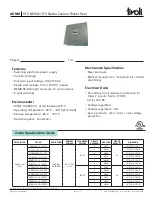
Page 15
PROTOCOL CONSIDERATIONS
As previously indicated, the module's transparency allows for virtually unlimited
protocol types and techniques.This section is meant only to illustrate general
issues a designer should address to ensure product reliability in the field. Your
application may call for or benefit from an entirely different protocol structure.
It is a good idea to structure the data being sent into small packets so that errors
can be managed without affecting large amounts of data. Packets should be
transmitted without space between bytes. When using a UART the following
packet format is often followed:
[ uart sync byte ] [ start byte ] [ data packet ]
The UART sync-byte is used to ensure that the start-bit for the start-byte will be
correctly detected. It is a single byte with a value of 255 (0FF hex). A start-byte
often follows the sync-byte to intelligently qualify the data-packet which will
follow. Detection of the start-byte would be performed by the computer or
microcontroller connected to the receiver.
TIMING CONSIDERATIONS
Timing plays a key role in link reliability especially when the modules are being
rapidly turned on and off or hopping channels. Unlike a wire, allowance must be
made for the programming and settling times of both the transmitter and receiver
otherwise portions of the signal being sent will be lost. There are two major
timing considerations the engineer must be aware of when designing with the
HP-3 Series transmitter. These are shown in the table below. Remember the
stated timing parameters assume a stable supply of 2.8 volts or greater. They do
not include the charging times of external capacitance on the module's supply
lines, the overhead of external software execution, or power supply rise times.
Parameter
Description
Max.
T
1
Transmitter Turn-on Time
10mSec
T
2
Max Channel-Change Time
1.5mSec
(Time to Valid Data)
T
1
is the maximum time required for the transmitter to power-up and lock on-
channel. This time is measured from the application of VCC to the CTS output
transitioning high.
T
2
is the worst-case time needed for a powered-up module to switch between
channels from a valid channel selection. This time does not include external
overhead for loading a desired channel in the serial channel-selection mode.
Normally, the transmitter will be turned off after each transmission. This is
courteous use of the airwaves and reduces power consumption. The transmitter
may be shutdown by switching its supply or the PDN pin. In power-down the
module is completely shut down. When the transmitter is again powered up
allowance must be made for the requirements above.
In many cases the transmitter will lock more quickly than the times indicated. In
instances where turn-around time or power consumption are critical the CTS pin
should be monitored so data can be sent immediately upon transmitter
readiness.










































